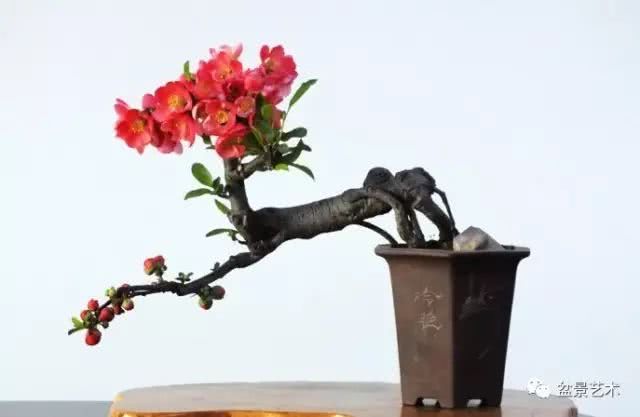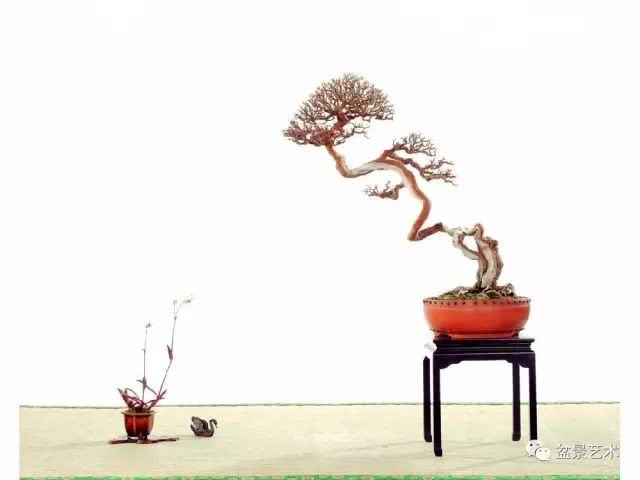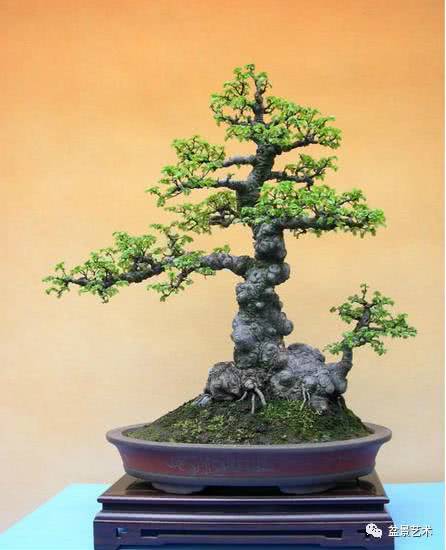The peculiar art of replacing dry bonsai with roots

Although there are many branches of Chinese wolfberry, Yingchun and other plants, they are not slender and stout, and there is no obvious trunk, but their roots are colorful and quaint. In addition, the roots of some miscellaneous wood stumps, such as bauhinia and bayberry, are simple and strange, but the trunk is straight and straight. When making bonsai with these plants, the method of "replacing dry with roots" can be used to remove the roots from the soil instead of tree trunks.
The difference between dry bonsai with roots and bonsai with exposed roots is: on the basis of retaining the original tree trunk, the bonsai with exposed roots can hang roots and show claws, and the shape of the roots is not changed, but only as a part of the ornamental body; while the trunk with roots instead of dry bonsai is completely replaced by roots, and the ornamental form of roots no longer exists, but appears in the form of trunk.
The stakes used to replace the dry bonsai with roots should choose those stumps with trunk shape at the roots, and the requirements for branches are not too strict. Planting time can be determined according to different tree species, generally in winter and spring, especially before sprouting in spring. Before planting, the pile should be trimmed and shaped, the unnecessary branches should be cut off, and the over-long branches should be truncated properly, but the thicker branches should be retained for future modeling, and the roots should be trimmed, and then planted in tile pots to raise blanks.
Because the root of Chinese wolfberry is thick and thin, it violates the natural law of thick and fine under the root, so it can be replanted upside down and easily survive, but its growth is weak. Stump planting should be deep, it is best to bury all the roots in the soil, if the flowerpot depth is not enough, linoleum can be rolled into a tube into the flowerpot, and then fill the soil to increase the height of the pot soil. When planting, the soil should be compacted and watered thoroughly.
When the weather is cold, it should be covered with transparent plastic bags for cold protection and heat preservation, and the newly planted plants should be maintained in a place away from the wind and the sun, keep the basin soil moist without stagnant water, and remove the plastic bags after living steadily. When the plant grows exuberantly, some mature thin liquid fertilizer is applied to the branches to grow freely, so as to produce more nutrients through leaf photosynthesis, so that the stump grows vigorously and the root system is developed.
After the leaves fall in winter, the redundant branches of tree stumps such as Yingchun and bauhinia will be cut off, and the long branches will be cut short. On the other hand, Chinese wolfberry should be pruned when it is about to sprout in spring, otherwise it will cause the branches to retreat (that is, the pruned branches will die). In the course of maintenance, part of the basin soil should be gradually removed to prepare for the root lifting in the future.
The root lifting of dry bonsai should be carried out step by step, not in too much haste, lest the fine roots are exposed too much, resulting in plant death, and its shape can be made into different forms of bonsai according to the specific shape of the roots. In the first year of moving the bonsai into the fine basin, the bonsai is planted in less fertile soil to make it adapt to the new environment and ensure survival. Wait until the next spring to turn the pot and then use more fertile soil to plant. After that, it can be managed normally according to the different habits of tree species.
- Prev

The main points of shaping the Tree Type of Literati
The so-called literati tree type refers to the tree type which is longer and thinner than the curved stem type, and removes the lower branches, and the number of branches is extremely rare. The literati tree, which has always been favored by poets and poets, gives people the feeling of being awe-inspiring and outstanding. The height of this tree.
- Next

Placement of several kinds of tree stump bonsai
The placement of tree stump bonsai is very fastidious, many pile friends have made a detailed introduction to the distance between pot stakes, air circulation, lighting and other aspects, which will not be described here. This article would like to make some brief comments on the placement of several different kinds of pot piles.
Related
- Wuhan Hospital Iron Tree Blooming Result Was Instantly Frightened by the Gardener Master
- Which variety of camellia is the most fragrant and best? Which one do you like best?
- What is the small blue coat, the breeding methods and matters needing attention of the succulent plant
- Dormancy time and maintenance management of succulent plants during dormancy
- Minas succulent how to raise, Minas succulent plant pictures
- What are the varieties of winter succulent plants
- How to raise succulent plants in twelve rolls? let's take a look at some experience of breeding twelve rolls.
- Attention should be paid to water control for succulent plants during dormant period (winter and summer)
- Watering experience of twelve rolls of succulent plants
- Techniques for fertilizing succulent plants. An article will let you know how to fertilize succulent plants.

